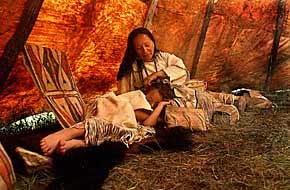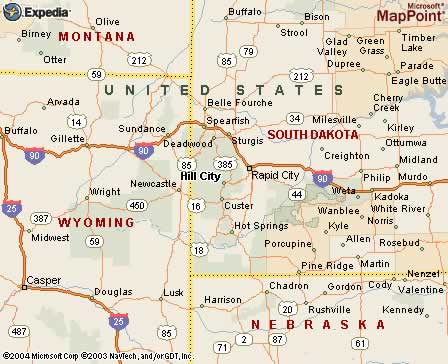|
|
Canku Ota |
|
|
(Many Paths) |
||
|
An Online Newsletter Celebrating Native America |
||
|
June 19, 2004 - Issue 115 |
||
|
|
||
|
Back to Basics: Ways of the Past Help Shape the Future |
||
|
by Dick Kettlewell, Journal photographer |
||
|
credits: Daynetta Bald Eagle strokes the hair of her daughter, Brenna, 7, as the child naps on a buffalo rug in the family's tipi at Wicoti near Hill City. Wicoti is a living Lakota village reflecting American Indian life as it was in 1804, when Lewis and Clark passed through the region. (Dick Kettlewell, Journal staff) |
 HILL
CITY -- Like those of her ancestors, the hands of Daynetta Bald
Eagle are seldom idle. Methodically they move, pushing the bone
needle through the deerskin, pulling the sinew tight and repeating
the motion as she sews a knife sheath. There is little wasted motion.
At the same time, she continues to talk with her guests. HILL
CITY -- Like those of her ancestors, the hands of Daynetta Bald
Eagle are seldom idle. Methodically they move, pushing the bone
needle through the deerskin, pulling the sinew tight and repeating
the motion as she sews a knife sheath. There is little wasted motion.
At the same time, she continues to talk with her guests.
"I do wish that I could have raised my children 200 years ago, in a place like this," she says. "I think it would have been a lot easier. Nowadays, there are so many distractions - gangs, drugs, so much violence - too much is asked of them and much too early." Bald Eagle sets her sewing aside for a moment and begins to stroke the hair of her 7-year-old daughter, Brenna, who has fallen asleep on a thick buffalo hide rug with her head in her mother's lap. This is Wicoti Living History Lakota Encampment, on the southern edge of Hill City just off U.S. Highway 16/385. It is a replica of a 1804 Lakota village and a reflection of life from that bygone time. The Lakota woman is seated on the floor of a tipi made from the brain-tanned hides of buffalo cows, in the way of the old Lakota. This hide tipi is different from the canvas ones that compose the rest of the village. Though the afternoon is quickly growing hotter, the inside of the tipi is still cool and comfortable. When the inevitable winds come up, the sides of a canvas tipi billow and flap noisily, but the hide tipi stands rigid and still. And the soft and soothing light in this house of hide invites peace and calm. Bald Eagle's guests are a grandmother, mother and five children from Washington state. All are interested in everything Bald Eagle has to say. The children ask many questions and obviously have done some reading about American Indian ways. "My husband, children and I lived in a tipi like this one for about a year and a half," Bald Eagle tells them. "When we moved back into a house, it was quite an adjustment for the children. They couldn't get used to sleeping in a room where you couldn't look up and see the stars." Outside the hide tipi, Bald Eagle's brother, Jay Red Hawk, rides about the encampment on Buffalo Boy, a huge and beautiful American paint stallion. Wearing the clothes and paint of the old Lakota warrior's society that honored the swift fox, Red Hawk answers the questions of other visitors. His personality is bright and infectious. Red Hawk says the mission of Wicoti goes much deeper than being merely another tourist attraction. "Our purpose is to educate people, especially young people, from both cultures, to build better relationships between them," Red Hawk said. "I never know when I might be talking to some kid who will grow up to be a leader, maybe even president, or the CEO of a major corporation. He may make decisions that will have a major effect on my people. Something he learns here may help him to better understand the effects of his decision." Red Hawk said young Lakotas also need to know more about their history. "It's hard to know where you are going if you don't know your past. If the kids don't get plugged into their cultural identity, I fear for their future," he said. |
|
|
www.expedia.com |
|
|
||
|
|
||
| Canku Ota is a free Newsletter celebrating Native America, its traditions and accomplishments . We do not provide subscriber or visitor names to anyone. Some articles presented in Canku Ota may contain copyright material. We have received appropriate permissions for republishing any articles. Material appearing here is distributed without profit or monetary gain to those who have expressed an interest. This is in accordance with Title 17 U.S.C. Section 107. | ||
|
Canku Ota is a copyright © 2000, 2001, 2002, 2003, 2004 of Vicki Barry and Paul Barry. |
||
 |
 |
|
|
The "Canku Ota - A Newsletter Celebrating Native America" web site and its design is the |
||
|
Copyright © 1999, 2000, 2001, 2002, 2003, 2004 of Paul C. Barry. |
||
|
All Rights Reserved. |
||
